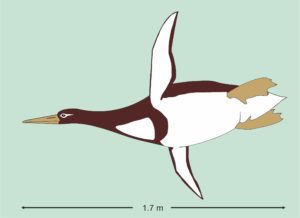A fossil penguin discovered in New Zealand has been identified as a new species and it was so tall it was about the height of an adult man.

Kumimanu biceae weighed in at around 100 kg and about 177 cm in height, which might have been the largest penguin to ever live. And dated to between 60-55 million years ago, it’s also the oldest known penguin species.
The German and New Zealand researchers’ discovery was published today in Nature Communications.
The SMC asked an Ancient DNA expert to comment on the discovery.
Dr Nic Rawlence, Director, Otago Palaeogenetics Laboratory, University of Otago, comments:
“This stunning new discovery of a truly giant fossil penguin Kumimanu, (around 100 kg and 177 cm in height), from north Otago is rewriting what we know of penguin evolution. With an age of around 55-60 million years old (that’s just 5-10 million years after the extinction of the dinosaurs and large predatory marine reptiles) Kumimanu shows that gigantism (larger than today’s Emperor Penguin) evolved very rapidly in penguin evolution, shortly after they became flightless. What’s the reason for the evolution of gigantism? Well, it may be penguins accepted a job vacancy in the ecosystem with the extinction of large predatory marine reptiles.
“Kumimanu is also millions of years older than the other giant penguins that have made New Zealand famous. Kumimanu is separated in the penguin family tree from other much younger giant penguins by several small penguins, indicating that true giants have evolved multiple times in penguin evolution – much like true giants have evolved multiple times in ratites (the bird family that includes the extinct moa and elephant bird, and the kiwi, emu, ostrich, cassowary and rhea we know today). It is likely that giant penguins, in general, went extinct with the radiation of whales and seals, (both giant marine predators), 20-30 million years ago.
“So why does New Zealand have all these ancient species – Leiopelma frogs, tuatara, and Kumimanu. Well, part of the story might be that Zealandia (the continent that New Zealand is part of) started to separate from the supercontinent Gondwana around 80 million years ago. On Zealandia, the ancestors of these ancient species could evolve in isolation, some obtaining truly gigantic sizes. On islands, birds can become true giants and in this case, this is just what may have happened with penguins 55-60 million years ago, of which Kumimanu is a perfect example.”
The discovery was covered widely by New Zealand and international media, including:
Newshub: Man-high ‘monster bird’ fossil found in Otago
The Conversation: New Zealand discovery of fossilised ‘monster bird’ bones reveals a colossal, ancient penguin
Otago Daily Times: Giant penguins roamed Otago
Newstalk ZB: Ancient penguin as big as a human once lived in New Zealand
The Guardian: Fossil hunters find man-sized penguin on New Zealand beach
USA Today: Big bird: Fossil of giant penguin discovered in New Zealand
New York Times: Ancient Penguins Were Giant Waddling Predators